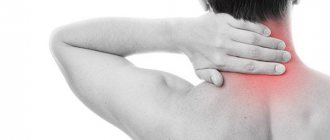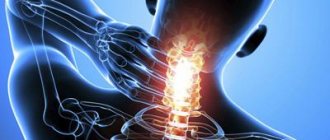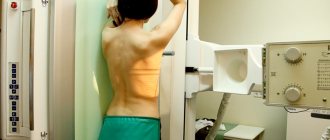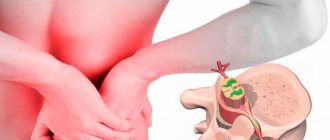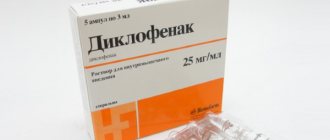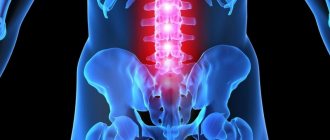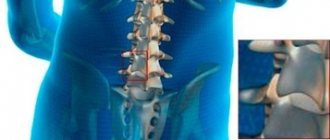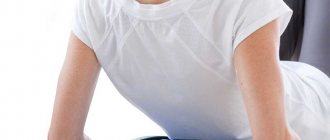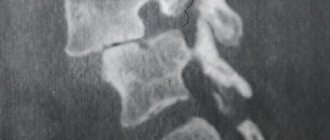What is a lumbar disc herniation?
Intervertebral hernia is a disease that occurs due to a violation of the integrity of the fibrous ring and displacement of the central part of the intervertebral disc. As a result, the spinal nerve endings are compressed and the surrounding soft tissues become inflamed.
A hernia is formed due to the progression of degenerative-dystrophic processes in the spine itself, which affected any of the elements between 2 (two) adjacent vertebrae.
To treat a hernia of the lumbar spine, you can contact our clinic “Aspect of Health” in Ufa.
Impact of massage
Massage tactics are aimed at improving tissue trophism (increasing blood flow and lymphatic drainage, supplying cells with nutrition and oxygen), relieving muscle tension, preventing atrophy, and reducing pressure on the intervertebral discs. They are prohibited from being used, as in the case of exercise therapy, during acute periods of illness. Massage and manual procedures are carried out strictly according to high-level indications by a specialist in neurology-orthopedics, since hernia is different.
Any reflexology should be performed very carefully and professionally, without tugging, twisting, or putting excessive pressure on the spine, so as not to further damage the weak disc and direct the protrusion in an unfavorable direction. For the same reason, it is undesirable to use all kinds of hernia reduction tactics; the effect can be completely opposite.
Massage for this area has many contraindications: volumetric protrusions (grade 3), sequestration, hypertension, kidney disease, etc. Massage techniques, if they are not contraindicated, should be considered exclusively in the context of the basic treatment process, and not as the only method of treatment. Massage and manual therapy are not a panacea; they will not cure a hernia without surgery, but they can be very useful for a “young”, just nascent hernia. Massage has invaluable benefits in restoring the spine after an operation has already been performed.
Types of intervertebral hernia
The general classification of intervertebral hernias includes the division of pathology depending on the location of the lesion in a specific part of the spine:
- neck;
- chest;
- lumbar
Locations within the spinal cord canal:
- near-median;
- posteromedial;
- posterolateral.
By size:
- 1-3 mm – protrusion;
- 3-6 mm – prolapse;
- 6-15 mm – developed hernia.
Anatomical feature:
- free;
- wandering;
- moving.
Particularly notable is Schmorl's hernia, which is the insertion of parts of the nucleus at the level of the spongy tissues of the vertebra, which does not cause compression of the spinal structures and nerve endings. Lumbar disc herniation is most often diagnosed at the level of the L4-L5 and L5-S1 vertebrae.
conclusions
- Conservative therapy cannot be an alternative to surgery, since it does not eliminate the hernia, but only has a symptomatic effect.
- According to clinical observations, at least 40% of patients treated conservatively have unsatisfactory results. After 6-12 months, they are operated on due to the ineffectiveness of previous treatment or complications that have developed.
- For stage 3 and stage 4 disease, surgical intervention (microdiscectomy, endoscopy) is indicated. At stage 4, due to the high risk of irreversible damage to the spinal cord and nerve bundles by sequestration, surgery to remove the sequester and correct the disc is prescribed on an emergency basis.
- If the non-invasive approach is 1-2 tbsp. pathology for 6 months has not been successful in combating pain or progression is noted on MRI, it is advisable to consider a minimally invasive method of removing the hernia (endoscopy, nucleoplasty).
The onset of symptoms of loss of sensitivity is a bad sign, foreshadowing the onset of paraplegia in the near future. In order to avoid a dramatic outcome in the form of paralysis, from which surgery does not help, it is important to undergo neurosurgical surgery within a limited time frame.
L4-L5
Lumbar hernia accounts for more than 50% of all cases of damage to this pathology of the spine, and in 46% it is at the level of the L4-L5 segment. The division occurs into the following types:
- median - located epidurally and often reaches large sizes. Can penetrate through the nerve sheath into the subarachnoid space;
- anterolateral - located outside the anterior circumference of the vertebral body. It is characterized by detachment of the longitudinal anterior ligaments, leading to the formation of sympathetic syndrome;
- posterolateral - passes through the back of the fibrous ring and from the side of the midline it passes in the place where median hernias appear, on the side (lateral), as well as next to the midline (paramedian).
Causes
The abdominal wall is a complex anatomical structure formed mostly by connective and muscle tissue. Its function is to support the internal organs in the abdominal cavity. A certain balance is developed between intra-abdominal pressure and the resistance of the abdominal wall. Sometimes this balance is disrupted, and the internal organs begin to leave the abdominal cavity through weak spots under the skin, forming an abdominal hernia, the photo or appearance of which eloquently indicates the presence of the disease. It is almost impossible to confuse it with another pathology.
The causes of hernias are:
- hereditary or acquired weakness of the abdominal wall;
- connective tissue diseases;
- age-related changes;
- prolonged fasting;
- obesity;
- ascites;
- pregnancy;
- physical stress;
- pushing during childbirth;
- chronic cough;
- constipation;
- lifting weights.
Injuries and postoperative scars can also contribute to the development of a hernia. A hernia can appear as a result of surgery if mistakes are made during suturing of the surgical wound. Therefore, postoperative consequences are often factors influencing the development of hernia formation, especially if they are purulent in nature. The cause of internal hernia is anomalies of embryonic development and chronic perivisceritis.
L5-S1
Such a lumbar intervertebral hernia is formed between the 5th lumbar and 1st sacral vertebrae. In the direction of displacement it happens:
- dorsal or posterior - towards the spinal canal;
- circular - uniform protrusion of the disc;
- foraminal - protrusion towards the lateral openings of the column, from where the nerve roots emerge;
- diffuse - uneven distribution of displacements in several places of the disk;
- paramedian or median - protrusion slightly from the center or directly to the center of the spinal cord canal.
The most dangerous are the posterior and foraminal variants. In the first case, the displaced disc and damaged nucleus come into contact with the cauda equina; in the second, it infringes on the nerve roots extending away from the spine.
Stages of development
Any stage of development of a lumbar hernia is accompanied by certain symptoms. The following stages are distinguished:
- Prolapse is a slight displacement of the disc, which falls into place if the provoking factors cease to act.
- Protrusion is a pronounced displacement, but within the boundaries of the spine.
- Extrusion - the nucleus emerges from the disc space.
- Sequestration - rupture and cracking of tissue occurs.
- Symptoms and signs of pathology
At the early stage of development of a hernia in the lumbar region, symptoms do not appear for a long time. Over time, the following clinical picture occurs:
- pain in the lower spine, buttock and leg (pain in the lower limb is generally more pronounced);
- restrictive mobility of the lumbar region;
- weakening of the leg muscles, up to paralysis;
- sharp shootings in the lower back;
- numbness and tingling in the buttocks, legs, or thigh;
- inability to move your toes or lift them;
- stoop due to poor posture;
- dysfunction of the pelvic organs (uncontrolled urination and defecation);
- asymmetrical body position;
- lameness;
- improper functioning of the sebaceous glands of the limb in which the nerves are affected.
Symptoms
Typical signs of intervertebral hernia of the lumbosacral region are:
- pain of varying degrees of intensity, decreasing when taking a supine position;
- increased pain during physical activity, walking, prolonged sitting;
- irradiation of pain to the buttocks, thighs, calves and feet of one or both legs;
- lumbago;
- limited mobility of the lumbosacral region;
- Sensitivity disorders of the skin of the legs and perineum;
- changes in the condition of the skin in the sacrum and lumbar region (redness, swelling);
- dysfunctions of the pelvic organs;
- weakness of the muscles of the lower extremities;
- pallor of the skin of the leg on the affected side;
- changes in gait, posture;
- smoothness of the gluteal fold.
Diagnostics
If unpleasant symptoms occur, you should contact a neurosurgeon to diagnose and identify the stage of development of a lumbar hernia. At the Aspect Health clinic, doctors will examine the patient and prescribe a CT or MRI examination (disc damage is visualized).
We remind you that the results of the images will not tell you about all the symptoms of the disease. In our clinic, we treat each patient individually, not based on the image, but based on the presence of certain symptoms.
There are several recommendations to follow:
- do not stay in one body position for a long time, it needs to be changed periodically;
- do more swimming, which has a positive effect on the spine;
- lie down more often, in this state the load is removed from the vertebrae;
- do not carry heavy objects;
- do not make sudden movements;
- Do not heat or overcool the affected area.
Prevention rules
As is known, deformation of intervertebral discs occurs against the background of regular or sudden load. Therefore, the most important point is to reduce this load. When sleeping at night, it is recommended to use an orthopedic mattress. It is best to fall asleep lying on your back.
It is also necessary to take a close look at your weight, since its excess has a negative effect on the spine. When performing a set of therapeutic exercises, it is advisable to avoid sudden movements and prolonged stress. Even at home, remember about correct posture, and try to change your body position more often when sitting.
Hernia treatment
There are two treatment methods: conservative and surgical.
Conservative treatment is divided into the following types:
- medicinal – based on taking various medications;
- non-medicinal.
Non-drug therapy, which consists of the following procedures:
- physiotherapy (laser therapy, electrophoresis, magnetic therapy, acupuncture, acupressure therapy, hirudotherapy, etc.);
- massage technique (used only during periods of no exacerbation);
- Exercise therapy (exercises designed to strengthen the muscles of the spine: careful rotations, turns, bending of the body).
Surgical intervention to remove a lumbar hernia involves the use of the following methods:
- discectomy (only part of the spinal disc is removed);
- laser reconstruction (excess moisture is removed from the damaged pulp);
- in advanced cases, the entire disc is removed and a prosthesis is placed.
Acute period
It lasts up to 1 week, and at this time a hernia of the lumbar spine is manifested by exudative inflammation. Here the doctor must decide whether surgery is required or not. Absolute indications for it are spinal stroke, pelvic disorders, reactive epiduritis, cauda equina syndrome. In other cases, conservative therapy is prescribed.
The patient requires pastel mode and the use of a fixation belt. It is important to minimize pain using analgesics. NSAIDs are also used, among which preference is given to Diclofenac and its analogues due to their speed of action. The complex necessarily contains decongestants, for example, Furosemide, Acetazolamide. Vascular medications and Novocaine-Dexon intradermal blockades are added.
Additional methods, the use of which is still controversial, include warming procedures, reflexology, magnetic laser therapy, electrophoresis
Subacute period
A lumbar hernia enters the subacute period at 2-3 weeks. Adhesions form around it, deforming the epidural space and compressing the nerve roots. If treatment for a lumbar disc herniation proceeds correctly, the pain will subside. Then pain relief and decongestant medications can no longer be used. The issue of manual therapy is resolved individually. Electrophoresis with lidocaine, lidase, sodium hydroxybutyrate and other medications is prescribed. If there are sensory disturbances, dorsanvalization, autonomic deviations, and magnetic therapy are added.
Recovery period
The recovery stage for a hernia of the lumbar spine begins at 4-6 weeks and can last up to six months. All medications are discontinued and exercise therapy is prescribed with exercises without turning, lifting heavy objects or bending. For paresis, electrical stimulation is added. The main goal is to eliminate pain.
Doctors do not recommend abandoning the fixation belt for lumbar hernia, even at the recovery stage. Positive changes are caused by balneotherapy, patients go to sanatoriums where various therapeutic baths are actively used, among which radon, sulfide, and hydrogen sulfide have the best effectiveness for lumbar intervertebral hernia. Turpentine baths will help relax muscles and relieve pain. Elderly people and patients with cardiovascular diseases are recommended to visit sodium chloride baths.
Features of surgical treatment
Modern medicine, in the fight against lumbar spinal hernias, increasingly places emphasis on minimally invasive surgical methods. In any case, operations are resorted to only in situations where all other methods have failed and in the presence of absolute indications that were listed earlier.
The effect of gymnastic exercises
Is it possible to keep a hernia under control using special physical exercises for the lumbar region? To be beneficial, gymnastic exercises must be recommended by an experienced rehabilitation therapist who holds your MRI image in his hands and is fully familiar with your physical characteristics and state of health. The first course should be carried out under the watchful supervision of a doctor in exercise therapy. Self-testing of gymnastic miracle workouts from the Internet is fraught with an increase and/or displacement of the hernial mass into the danger zone with increased neurological deficit.
The beneficial effect of gymnastic exercises, developed individually for each patient, is to activate blood circulation in the affected area, strengthen and unload the muscles, straighten the vertebrae and increase the intervertebral space. Regular, properly planned training helps reduce the frequency of relapses and improve motor capabilities. A good addition to exercise therapy will be classes in the pool under the supervision of a swimming and aqua gymnastics instructor.
However, during the acute period, exercise is contraindicated until the signs of exacerbation are eliminated with rest and medication. In addition, physical impact (traction in particular) on the lower back for large hernias (>8 mm), even for therapeutic purposes, can do more harm than good. Therefore, experts emphasize that such patients, first of all, need to have a hernia operated on as early as possible, and only then engage in productive restoration of the musculoskeletal system and the central nervous system through physical therapy.
Complications and consequences
If you do not take action to treat a lumbar disc herniation, there is a risk of developing lumbomyalgic crises. These are localized, wave-like pains that last for several days. The crises are then replaced by sciatica syndrome, where pain occurs in a specific location, such as the leg. Over time, it migrates to the distal zone of innervation of the sciatic nerve - the groin or thigh.
Paresthesia in the lower parts of the legs should alert you, which may indicate a risk of deterioration in motor activity, including muscle atrophy.
Serious complications of a lumbar hernia can affect the genitourinary system, which in men can be accompanied by impaired potency and gynecological pathology in women. And the most dangerous consequence is paralysis of the lower limbs.
Preventive measures
It is impossible to prevent the development of a hernia, but it is possible to reduce the risk of its occurrence. To do this you need:
- give up bad habits - drug addiction, smoking, drinking alcohol;
- create a complete diet and follow it;
- choose adequate physical activity;
- if the work involves staying in one position for a long time, take breaks and work out all muscle groups;
- do daily exercises;
- control weight, preventing body mass index from increasing above established norms.
For some, such recommendations are a radical lifestyle change. However, it is their implementation that will increase the quality of life and maintain your health.
Not a single person is immune from the appearance of a hernia. Knowing the symptoms of a hernia will help you notice it in the early stages and promptly consult a doctor to receive proper treatment.
